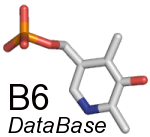Wang R, Han X, Xu S, Xia B, Jiang Y, Xue Y, Wang RR (2019)
Cloning and characterization of a tyrosine decarboxylase involved in the biosynthesis of galanthamine in Lycoris aurea PeerJ
7 e6729.
Luqman A, Nega M, Nguyen MT, Ebner P, Götz F (2018) SadA-Expressing Staphylococci in the Human Gut Show Increased Cell Adherence and Internalization Cell Rep 22 535-545.
Jadaun JS, Sangwan NS, Narnoliya LK, Tripathi S, Sangwan RS (2017) Withania coagulans tryptophan decarboxylase gene cloning, heterologous expression, and catalytic characteristics of the recombinant enzyme Protoplasma 254 181-192.
Liang J, Han Q, Ding H, Li J (2017) Biochemical identification of residues that discriminate between 3,4-dihydroxyphenylalanine decarboxylase and 3,4-dihydroxyphenylacetaldehyde synthase-mediated reactions Insect Biochem Mol Biol 91 34-43.
Kalb D, Gressler J, Hoffmeister D (2016) Active-Site Engineering Expands the Substrate Profile of the Basidiomycete L-Tryptophan Decarboxylase CsTDC Chembiochem 17 132-6.
Liu J, Ng T, Rui Z, Ad O, Zhang W (2014) Unusual acetylation-dependent reaction cascade in the biosynthesis of the pyrroloindole drug physostigmine Angew Chem Int Ed Engl 53 136-9.
Charoonratana T, Wungsintaweekul J, Keawpradub N, Verpoorte R (2013) Molecular cloning and expression of tryptophan decarboxylase from Mitragyna speciosa Acta Physiologiae Plantarum 35 2611-2621.
Wang MX, Cai ZZ, Lu Y, Xin HH, Chen RT, Liang S, Singh CO, Kim JN, Niu YS, Miao YG. (2013) Expression and functions of dopa decarboxylase in the silkworm, Bombyx mori was regulated by molting hormone. Mol Biol Rep. 40 4115-22..
Liu W, Chen R, Chen M, Zhang H, Peng M, Yang C, Ming X, Lan X, Liao Z. (2012) Tryptophan decarboxylase plays an important role in ajmalicine biosynthesis in Rauvolfia verticillata. Planta. 236 239-50.
Lehmann T, Pollmann S (2009) Gene expression and characterization of a stress-induced tyrosine decarboxylase from Arabidopsis thaliana FEBS Lett. 583 1895-900.
Park S, Kang K, Lee K, Choi D, Kim YS, Back K. (2009) Induction of serotonin biosynthesis is uncoupled from the coordinated induction of tryptophan biosynthesis in pepper fruits (Capsicum annuum) upon pathogen infection. Planta 230 1197-206.
Hare EE, Loer CM. (2004) Function and evolution of the serotonin-synthetic bas-1 gene and other aromatic amino acid decarboxylase genes in Caenorhabditis BMC Evol Biol 4 24.
Yamazaki, Y.; Sudo, H.; Yamazaki, M.; Aimi, N.; Saito, K. (2003) Camptothecin biosynthetic genes in hairy roots of Ophiorrhiza pumila: cloning, characterization and differential expression in tissues and by stress compounds Plant Cell Physiol 44 395-403.
Burkhard, P.; Dominici, P.; Borri-Voltattorni, C.; Jansonius, J. N.; Malashkevich, V. N. (2001) Structural insight into Parkinson's disease treatment from drug- inhibited DOPA decarboxylase Nat Struct Biol 8 963-7.
Facchini PJ, Huber-Allanach KL, Tari LW. (2000) Plant aromatic L-amino acid decarboxylases: evolution, biochemistry, regulation, and metabolic engineering applications Phytochemistry 54 121-38.
Muller, R.; Gerth, K.; Brandt, P.; Blocker, H.; Beyer, S. (2000) Identification of an L-dopa decarboxylase gene from Sorangium cellulosum So ce90 Arch Microbiol 173 303-6.
Maldonado-Mendoza, I.E.; Lopez-Meyer, M.; Galef, J.R.; Burnett, R.J.; Nessler, C.L.
(1996) Molecular analysis of a new member of the opium poppy tyrosine/3,4-dihydroxyphenylalanine decarboxylase gene family Plant Physiol 110 43-9.
Moore, P.S.; Dominici, P.; Borri Voltattorni, C. (1996) Cloning and expression of pig kidney dopa decarboxylase: comparison of the naturally occurring and recombinant enzymes Biochem J 315 249-56.
Hiruma, K.; Carter, M. S.; Riddiford, L. M. (1995) Characterization of the dopa decarboxylase gene of Manduca sexta and its suppression by 20-hydroxyecdysone Dev Biol 169 195-209.
Kawalleck, P.; Keller, H.; Hahlbrock, K.; Scheel, D.; Somssich, I.E. (1993) A pathogen-responsive gene of parsley encodes tyrosine decarboxylase J Biol Chem 268 2189-94.
Park, D. H.; Kim, K. T.; Choi, M. U.; Samanta, H.; Joh, T. H. (1992) Characterization of bovine aromatic L-amino acid decarboxylase expressed in a mouse cell line: comparison with native enzyme Brain Res Mol Brain Res 16 232-8.
De Luca, V.; Marineau, C.; Brisson, N. (1989) Molecular cloning and analysis of cDNA encoding a plant tryptophan decarboxylase: comparison with animal dopa decarboxylases Proc. Natl. Acad. Sci. U.S.A. 86 2582-6.
Ichinose, H.; Kurosawa, Y.; Titani, K.; Fujita, K.; Nagatsu, T. (1989) Isolation and characterization of a cDNA clone encoding human aromatic L-amino acid decarboxylase Biochem Biophys Res Commun 164 1024-30.











